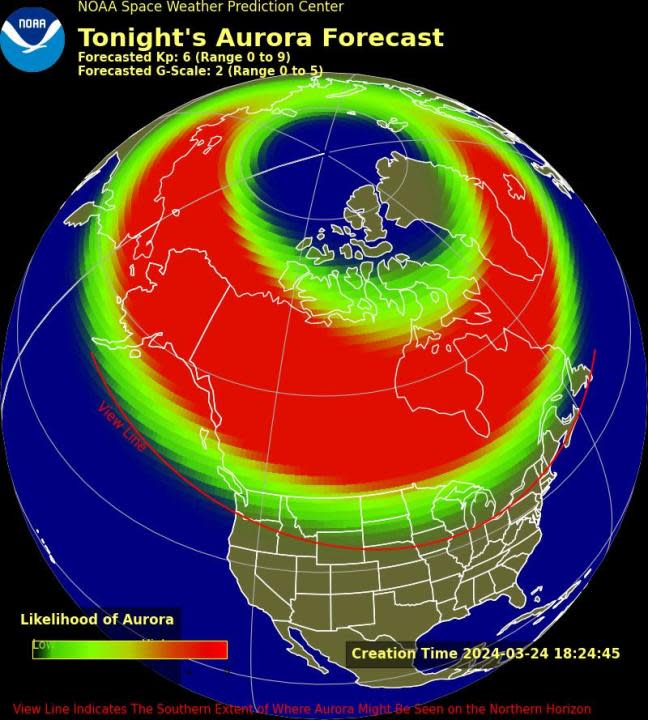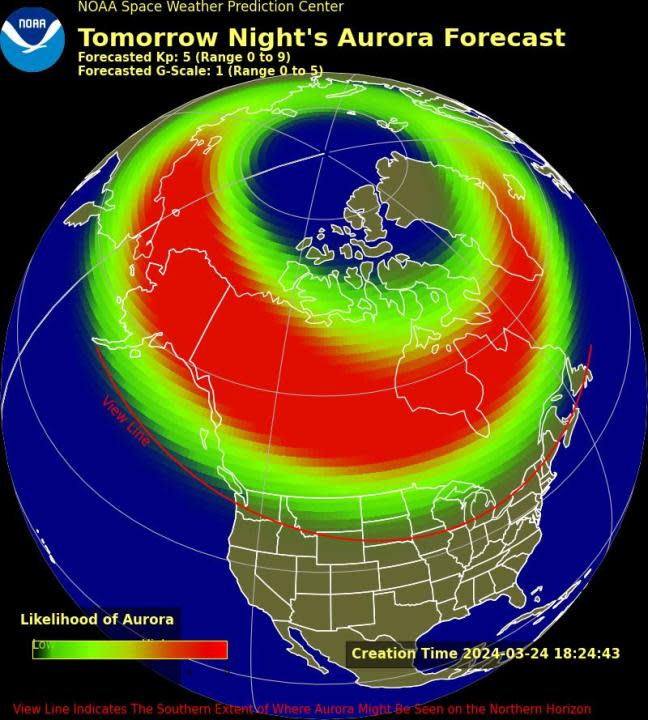‘Severe’ geomagnetic storm conditions impacting Earth, NOAA says: What to know

(NEXSTAR) — A major geomagnetic storm is impacting Earth, the NOAA Space Weather Prediction Center (SWPC) said Sunday afternoon. The U.S., however, may not see the aurora commonly associated with such celestial events.
Saturday, the SWPC issued geomagnetic storm watches through Monday as a coronal mass ejection was on track to impact Earth. At the time, the agency said the geomagnetic storms could reach G2 “moderate” and G3 “strong” strength.
However, on Sunday, the SWPC warned that the storm had reached “severe” G4 conditions. Those conditions could change into Monday, the agency said in a Sunday evening update.
Here’s what we know:
What is a coronal mass ejection?
A coronal mass ejection, or CME, is an explosion of plasma and magnetic material from the sun that can reach Earth in as little as 15 to 18 hours, NOAA explains. According to NASA, CMEs can create currents in Earth’s magnetic fields that send particles to the North and South Poles. When those particles interact with oxygen and nitrogen, they can create the northern lights.
“It’s essentially the Sun shooting a magnet out into space,” Bill Murtagh, program coordinator for the SWPC and seasoned space weather forecaster, previously told Nexstar. “That magnet impacts Earth’s magnetic field and we get this big interaction.”
Penumbral lunar eclipse set to happen early Monday morning: What to know
That interaction is known as a geomagnetic storm, the strength of which will impact how far south the northern lights will be visible.
How are geomagnetic storms measured?
The SWPC uses a 5-point scale to measure the strength of geomagnetic storms, much like forecasters use scales for tornadoes and hurricanes.
The geomagnetic storm scale ranges from G1 to G5. At the lowest end is G1, described as minor storms that can lead to aurora being visible in Maine and Michigan’s Upper Peninsula. A G5 storm, described as extreme, could send the northern lights as far south as Florida and southern Texas.
The moon is shrinking, study shows: What impact it could have
Geomagnetic storms can also impact our navigation, communication and radio signals. When major solar activity is seen, the SWPC issues an alert, Dr. Delores Knipp, a research professor in the Ann and H.J. Smead Aerospace Engineering Sciences Department at the University of Colorado Boulder, previously told Nexstar. This warns those using high-frequency radios (like emergency managers), airlines, and those in charge of our electrical grid of the possible impacts on our communication systems, GPS, and electricity.
A G1 storm can have minor impacts on the power grid, satellite operations, and migratory animals. A much larger storm can knock out satellites, communications, and power grids.
How serious is this storm?
The SWPC noted Sunday afternoon that geomagnetic storming reaching G4 conditions had been reported. In a newer update, the agency said levels “to at least G3” are expected through Sunday evening.
The G4 storming observed Sunday is considered “severe,” the SWPC notes, saying a storm of this caliber is “a major disturbance in Earth’s magnetic field; often varying intensity between lower levels and severe storm conditions over the course of the event.” As alarming as it may sound, the agency is advising otherwise.
“The public should not anticipate adverse impacts and no action is necessary, but they should stay properly informed of storm progression by visiting our webpage,” the SWPC said in a Sunday update, adding that “infrastructure operators have been notified to take action to mitigate any possible impacts.”
Northern lights could ramp up next year, and so could these strange occurrences
Officials also noted that there may be increased and more frequent voltage control problems that are “normally mitigable;” an increased chance at “anomalies or effects to satellite operations;” and “more frequent and longer periods of GPS degradation possible.”
“Changes in the strength of the geomagnetic storm levels will occur due to variations in solar wind as the CME continues to pass over Earth,” the SWPC said Sunday evening.
Will we see the northern lights?
Unfortunately for the U.S., the strong activity noted on Sunday afternoon happened during daylight hours. The SWPC’s current forecast models show that those in northern Europe and Asia may be seeing some aurora, but it may not hold through for the U.S.
“It is possible the best conditions will be wasted in the United States because it’s still daytime,” Eric Snitil, chief meteorologist at Nexstar’s WROC said.
Sunday evening, the SWPC said that if G4 levels are reached as the night goes on, the northern lights could be visible “over much of the northern half of the country, and maybe as far south as Alabama to northern California.”
“Bottom line, it’s now a wait-and-see game we’ll be playing,” Snitil said. “Time will tell if this show has enough gas in the tank to keep going beyond nightfall locally,”
Is tap water safe to drink? CDC report highlights deadly waterborne infections
As of 2:30 p.m. ET, the SWPC’s forecast showed those in the northern U.S. could still get a glimpse of the auroras Sunday and Monday night. The latter forecast may change by Monday morning.


If you don’t get to see the northern lights on Sunday, have no fear — we’ll likely have another chance soon enough.
According to NOAA, we’re nearing the peak of Solar Cycle 25, an 11-year period in which it flips its north and south poles. During this time, various space weather events can occur that can bring geomagnetic storms — and the northern lights — to us on Earth.
For the latest news, weather, sports, and streaming video, head to Queen City News.

